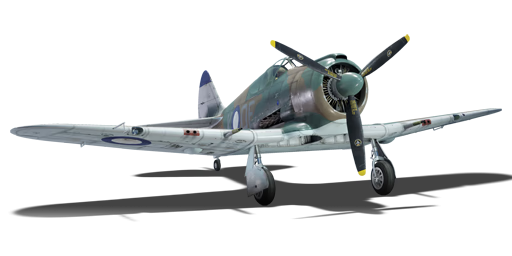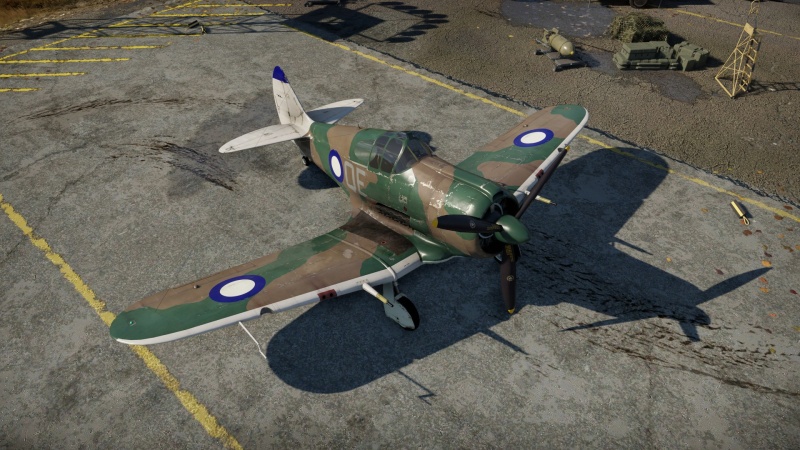Boomerang Mk II (Great Britain)
| This page is about the British fighter Boomerang Mk II (Great Britain). For the other version, see Boomerang Mk I (Great Britain). |
Contents
Description
The ▄Boomerang Mk II is a premium rank II British fighter with a battle rating of 3.3 (AB), 3.0 (RB), and 2.7 (SB). It has been in the game since the start of the Open Beta Test prior to Update 1.27. Buying the plane requires the purchase of the Boomerang Mk I to unlock. This variant of the Boomerang represents a version which was designed and manufactured in Australia.
The Boomerang Mk II is very near identical plane compared to the first Mk I Boomerang. The plane can out-turn almost any plane, save for Japanese planes. The Boomerang Mk II is lacking in the amount of ammo for the cannons. Some good tactics are to stay low to the ground, and like with all planes, keep a good eye on where each plane is, in AB stay low and "mow the yard" anything that comes close, just prepare to turn-fight them, and take them out, be cautious with your cannon ammo, as those are your only "heavy" hitting guns. If you are going to fight the Mk II or Mk I, do NOT attempt to turn-fight them unless you are flying a Japanese aircraft. Instead, Boom & Zoom or catch them when they're reloading and flying off when they are a much easier target in those situations, however, if it does manage to avoid your attacks, don't stick around for long.
This is a fantastic plane for its battle rating, most will be put off for its rather odd situation with having to buy the first Boomerang before gaining access this version, which to some has no real outstanding differences. A good pro to this aircraft is if you really like the Mk 1 Boomerang, and get good kills in it, then this serves as a "permanent backup" which only has a slightly increased climb rate. Downsides to the Boomerang is that it is rather slow when compared to other aircraft of its tier. Keep in mind that low altitude fighting is its bread and butter and can easily out-turn just about everything in arcade battles and in realistic battles.
General info
Flight performance
| Characteristics | Max Speed (km/h at 5,100 m) |
Max altitude (metres) |
Turn time (seconds) |
Rate of climb (metres/second) |
Take-off run (metres) | |||
|---|---|---|---|---|---|---|---|---|
| AB | RB | AB | RB | AB | RB | |||
| Stock | 472 | 456 | 10356 | 23.2 | 23.9 | 12.1 | 12.1 | 273 |
| Upgraded | 513 | 491 | 21.4 | 22.3 | 18.3 | 14.9 | ||
Details
| Features | ||||
|---|---|---|---|---|
| Combat flaps | Take-off flaps | Landing flaps | Air brakes | Arrestor gear |
| ✓ | ✓ | ✓ | X | X |
| Limits | ||||||
|---|---|---|---|---|---|---|
| Wings (km/h) | Gear (km/h) | Flaps (km/h) | Max Static G | |||
| Combat | Take-off | Landing | + | - | ||
| 660 | 320 | 487 | 445 | 225 | ~12 | ~9 |
| Optimal velocities (km/h) | |||
|---|---|---|---|
| Ailerons | Rudder | Elevators | Radiator |
| < 380 | < 370 | < 340 | > 323 |
Survivability and armour
- 38 mm Bulletproof glass - Armoured windscreen
- 12.7 mm Steel - Armoured plate behind the pilot, with 3 mm steel plate flaps around it
Modifications and economy
Armaments
Offensive armament
The Boomerang Mk II (Great Britain) is armed with:
- 2 x 20 mm Hispano Mk.II cannons, wing-mounted (60 rpg = 120 total)
- 4 x 7.7 mm Browning machine guns, wing-mounted (1,000 rpg = 4,000 total)
Usage in battles
Describe the tactics of playing in the aircraft, the features of using aircraft in a team and advice on tactics. Refrain from creating a "guide" - do not impose a single point of view, but instead, give the reader food for thought. Examine the most dangerous enemies and give recommendations on fighting them. If necessary, note the specifics of the game in different modes (AB, RB, SB).
Manual Engine Control
| MEC elements | ||||||
|---|---|---|---|---|---|---|
| Mixer | Pitch | Radiator | Supercharger | Turbocharger | ||
| Oil | Water | Type | ||||
| Controllable | Controllable Not auto controlled |
Controllable Not auto controlled |
Controllable Not auto controlled |
Separate | Controllable 2 gears |
Not controllable |
Pros and cons
Pros:
- Great turning speed
- Premium aircraft gives a boost in silver lion and research points
- Decent secondary guns, can catch enemies on fire easily with tracer bullets
- Slightly increased rate of climb
- Cannons have a wide variety of ammo options
Cons:
- Low ammo count for the 20 mm cannons
- Rather slow compared to others
- Japanese planes relying on turn ability will outmanoeuvre the Boomerang
- Engine catches fire easily
History
The Boomerang Mk II is the second variant of the CAC Boomerang, a fighter aircraft developed by Australia's Commonwealth Aircraft Corporation (CAC). Designed to equip the RAAF after the start of the Second World War, the aircraft was the first indigenously-built Australian fighter aircraft. The Boomerang was very underpowered due to the limited engine choices, meaning that it was considerably slower than its contemporaries. The aircraft saw limited active service during the Second World War in both frontline and secondary duties.
In the late 1930s, with Nazi Germany and Japan both rapidly increasing the size of their militaries, the Australian Air Force (RAAF) looked to acquire a new fighter aircraft to replace their obsolete squadrons of F2A Buffalos. Following the start of the war, the RAAF was hard-pressed for fighters: the UK, Australia's primary source for aircraft, was barely supplying enough aircraft for itself, while the USA dedicated almost all of its manufacturing capacity to producing aircraft for the USAAF and USN. As a result, Australia was forced to produce a new fighter indigenously.
The RAAF turned to the CAC, which had been created in 1936 through the merger of several Australian aircraft companies. The CAC was already producing the Wirraway, a training and general-purpose aircraft; the CAC decided to create a new fighter on the basis of the Wirraway, as this could be done quickly and efficiently. The Wirraway's rear fuselage, tail and wings were mated to a new forward fuselage which housed a 1200 hp Pratt & Whitney twin wasp engine. This prototype configuration first flew in May of 1942 and was later ordered into service as the Boomerang Mark I (contract number CA-12) - a total of 105 Boomerang Mk Is would be built during the war.
Later on, CAC developed a new variant of the Boomerang, designated the CA-13: this would be known in service as the Boomerang Mk II. The Boomerang Mk II incorporated numerous minor changes, including the switch from fabric construction to duralinium and the replacement of the hydraulic weapon actuators with mechanical ones. In total, 95 Boomerang Mk IIs were built for a total of 200 Boomerangs in total, not including prototype aircraft.
In service, the Boomerang proved to be very underpowered and much slower than most comparable allied fighters. In fact, the Boomerang never shot down a single enemy aircraft. The Boomerang proved to be more effective as a ground attack aircraft, replacing the lighter-armed Wirraway in this role: it was frequently used to drop ordnance or strafe enemy targets, or deploy smoke bombs to mark enemy targets. The Boomerang was retired soon after the war's end; three Boomerang Mk IIs still exist today alongside five Boomerang Mk Is, including a single currently-airworthy aircraft.
In-game description
The CAC Boomerang was an Australian light single-seat fighter. This single-engine monoplane was based heavily on the CAC Wirraway trainer but was armed with two 20mm cannons and four 0.303 inch machine guns. The aircraft had solid handling qualities at low altitudes, but a mediocre performance at height and a poor top speed.
After the first batch of Boomerang Mk I aircraft (also known as CA-12s) was completed, a CA-13 or Mk II modification was released which incorporated some minor changes: to improve the handling of the rudders and ailerons the fabric in their construction was replaced with duralumin and a larger tailfin and rudder was developed. In addition, the wings were sheathed with plywood instead of duralumin, and the wing tips were replaced with wooden ones. The shape of the exhaust pipe was changed to the characteristic Beaufort shape. A new propeller and geared cooling fan were also fitted to boost performance, although the planned supercharger was dropped from production models due to component priority being given to Spitfires and Mustangs. Still, the Boomerang Mk II's performance was noticeably superior to that of the Mk I. 95 CA-13 Boomerang Mk.IIs were produced, with a further 49 CA-19s being manufactured with various minor modifications.
Media
- Skins
- Videos
See also
Links to the articles on the War Thunder Wiki that you think will be useful for the reader, for example:
- reference to the series of the aircraft;
- links to approximate analogues of other nations and research trees.
External links
| Commonwealth Aircraft Corporation (CAC) | |
|---|---|
| Attackers | ▄Wirraway |
| Fighters | ▄Boomerang Mk I · ▄Boomerang Mk II |
| Britain premium aircraft | |
|---|---|
| Fighters | Tuck's Gladiator Mk II · ▄Boomerang Mk I · ▄Boomerang Mk II · ▄D.520 |
| ▄Martlet Mk IV · ▄Corsair F Mk II · ▄Hellcat Mk II · ▄Thunderbolt Mk.1 · ▄Mustang Mk IA | |
| Hurricane Mk.I/L FAA M · Spitfire Mk.IIa Venture I · Spitfire F Mk IXc · Plagis' Spitfire LF Mk IXc · Spitfire F Mk XIVc · Prendergast's Spitfire FR Mk XIVe | |
| Typhoon Mk Ib · MB.5 | |
| Twin-engine fighters | Hornet Mk.I · Whirlwind P.9 |
| Jet fighters | Attacker FB.2 · Hunter FGA.9 · Lightning F.53 · Meteor F Mk.8 Reaper · Sea Vixen F.A.W. Mk.2 · F-4J(UK) Phantom II · ▄MiG-21 Bison |
| Strike aircraft | ▄Wirraway · Beaufighter Mk I (40-mm) · Wyvern S4 |
| Harrier GR.1 · Strikemaster Mk.88 | |
| Bombers | ▄Avenger Mk II · ▄Boston Mk I · ▄Catalina Mk IIIa · ▄DB-7 · ▄Havoc Mk I · ▄Hudson Mk V · Swordfish Mk II |





